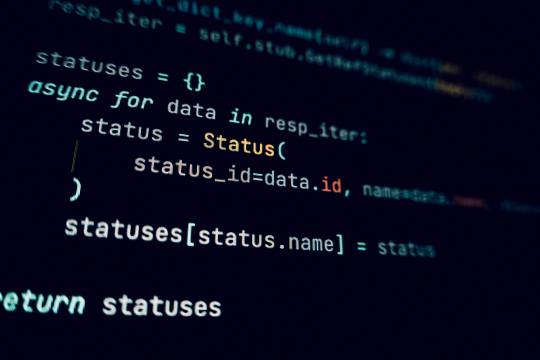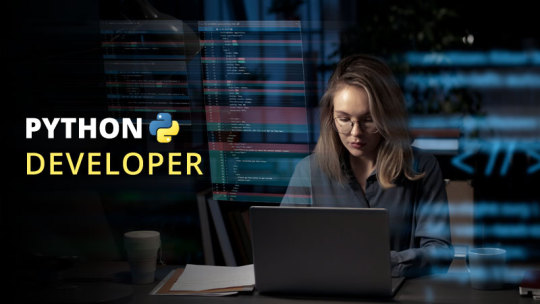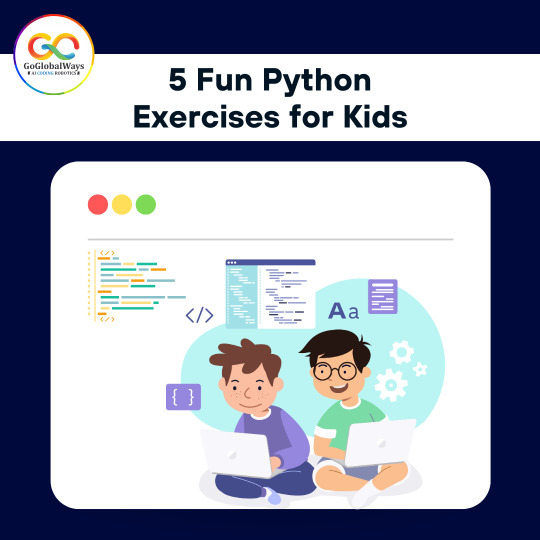#pythonprojects
Explore tagged Tumblr posts
Text
Why Learning Python is the Perfect First Step in Coding
Learning Python is an ideal way to dive into programming. Its simplicity and versatility make it the perfect language for beginners, whether you're looking to develop basic skills or eventually dive into fields like data analysis, web development, or machine learning.
Start by focusing on the fundamentals: learn about variables, data types, conditionals, and loops. These core concepts are the building blocks of programming, and Python’s clear syntax makes them easier to grasp. Interactive platforms like Codecademy, Khan Academy, and freeCodeCamp offer structured, step-by-step lessons that are perfect for beginners, so start there.
Once you’ve got a handle on the basics, apply what you’ve learned by building small projects. For example, try coding a simple calculator, a basic guessing game, or even a text-based story generator. These small projects will help you understand how programming concepts work together, giving you confidence and helping you identify areas where you might need a bit more practice.
When you're ready to move beyond the basics, Python offers many powerful libraries that open up new possibilities. Dive into pandas for data analysis, matplotlib for data visualization, or even Django if you want to explore web development. Each library offers a set of tools that helps you do more complex tasks, and learning them will expand your coding skillset significantly.
Keep practicing, and don't hesitate to look at code written by others to see how they approach problems. Coding is a journey, and with every line you write, you’re gaining valuable skills that will pay off in future projects.
FREE Python and R Programming Course on Data Science, Machine Learning, Data Analysis, and Data Visualization

#learntocode#python for beginners#codingjourney#programmingbasics#web development#datascience#machinelearning#pythonprojects#codingcommunity#python#free course
10 notes
·
View notes
Text
Python Projects with source code
Hello Python enthusiasts!
I'm excited to announce that my website, SamCodeHub, is now live and ready to be explored!
Website link: samcodehub.com
What you'll find on the site:
Programming tutorials in Python. Over 400 fascinating Python projects with source code. Step-by-step guides for beginners and advanced users. Whether you're just starting your Python journey or looking to improve your skills, SamCodeHub has something for everyone!
I would be incredibly grateful if you could take a moment to visit the website and share your feedback and opinions. Your input means a lot to me!
So, click on the link, dive into the world of Python, and let me know what you think! Feel free to share it with other Python enthusiasts as well!
Happy coding!
2 notes
·
View notes
Text

Bring your imagination to life and hone your tech skills with Heartening Raspberry Pi projects that are more practical than theoretical. Raspberry Pi projects. No matter if you have interest in electronics, IoT, robotics, or automation-these projects prove to be suitable for Computer Science, Electronics, as well as Electrical engineering students. Construct authentic solutions for the world, improve your CV, and remain in front of the competition in technology!
Types of Raspberry Pi Projects for Engineering Students Raspberry Pi is truly the breakthrough invention that will take up engineering students building ground breaking yet real-time applications. Some of the most common types of Raspberry Pi projects are:
1. Through Internet of Things (IoT) projects, sensors and devices can be connected to the internet for making advanced homes, weather stations, or health monitoring systems.
2. Automate anything from lights and appliances to security systems with Raspberry Pi and Python.
3. Using motor drivers and Raspberry Pi, a robotic project would control robots that may be line followers or robotic arms.
4. AI and ML projects simulate basic image recognition, voice assistants, or face detection modelling in Python and TensorFlow Lite.
5. Networking is where mini-servers, VPNs, or network scanners can be made using Raspberry Pi.
6. Projects of Media and Entertainment create smart mirrors and media centers and also game emulators for some fun and learning.
7. Educational projects will create learning kits for kids, digital notice boards, or interactive classroom tools.
It is the best medium for undergraduate students who are interested in practical study in the domains of computer science, electrical, electronics, electronic systems, and telecommunications engineering.
#RaspberryPi#EngineeringProjects#IoTProjects#Automation#RoboticsWithPi#AIProjects#PythonProjects#FinalYearProjects#CSEProjects#EEEProjects#EmbeddedSystems#StudentInnovators#TakeoffEduGroup#Takeoffprojects
0 notes
Text

Quiz Time!
Do you know what PEP 8 is in Python?
👉 Choose the right answer from the options below!
1️⃣ Version of Python 2️⃣ Third-party library 3️⃣ Testing framework 4️⃣ Python code style guide
PEP 8 helps Python developers write clean and readable code. It’s a must-know for every Python programmer!
📌 Learn more about Python Full Stack Development and level up your coding skills! 🌐 www.pythonfullstackmasters.in 📞 +91 9704944488 📍 Location: Hyderabad, Telangana
#PythonFullStack#PEP8#PythonQuiz#PythonBasics#LearnPython#PythonDeveloper#PythonStyleGuide#CodeWithPython#FullStackDevelopment#PythonTips#PythonLearning#PythonTraining#PythonProjects#TechQuiz#PythonCommunity#CodingLife#ProgrammerLife#DevelopersOfIndia#WebDevelopment#DjangoDeveloper
0 notes
Text
Python Crash Course by Eric Matthes is a beginner-friendly guide designed to teach Python programming through hands-on projects. The book is structured to take readers from the basics of Python to building real-world applications, making it ideal for beginners and those looking to solidify their Python skills. Below is a step-by-step breakdown of the key outcomes and takeaways from the book:
#Python#PythonCrashCourse#PythonProgramming#PythonForBeginners#Programming#PythonTutorial#LearnPython#PythonCode#TechBooks#PythonDevelopment#SoftwareDevelopment#PythonProjects#PythonLearning#TechEducation#Coding#PythonBasics#ProgrammingLanguages#Python3#PythonTips#PythonCommunity#PythonAppDevelopment#TechTutorial#ProgrammingBooks#PythonSkills#BeginnerProgramming#PythonGuide
0 notes
Text
Checkout my bio
#study #math #statistics #pythonprogramming #microsoftexcel #msexcel #Rstudio #spss #STATA #matlab #mathlab

#maths#mathskills#statistics#rstudio#stata#spss assignment help#matlab#ms excel#microsoft excel#pythonprogramming#pythonprojects
0 notes
Text
𝐁𝐮𝐢𝐥𝐝 𝐚 𝐌𝐨𝐯𝐢𝐞 𝐑𝐞𝐜𝐨𝐦𝐦𝐞𝐧𝐝𝐚𝐭𝐢𝐨𝐧 𝐄𝐧𝐠𝐢𝐧𝐞 𝐰𝐢𝐭𝐡 𝐏𝐲𝐭𝐡𝐨𝐧 𝐒𝐭𝐞𝐩-𝐛𝐲-𝐒𝐭𝐞𝐩
In today’s digital landscape, recommendation engines play a critical role in delivering personalized user experiences. From Netflix and Amazon to Spotify and YouTube, these systems help users discover content they love while driving engagement and retention for businesses. In this in-depth tutorial, you'll learn how to build a recommendation engine using Python. Whether you're a data science student, software engineer, or machine learning enthusiast, this hands-on project will walk you through the entire process — from understanding the fundamentals to coding your own movie recommendation system.
watch https://youtu.be/alncP9nWZYQ
#RecommendationEngine#DataScienceWithPython#PythonProjects#MachineLearning#CollaborativeFiltering#ContentBasedFiltering#MovieRecommender#DataScienceTutorial#PythonMachineLearning#Personalization#ScikitLearn#PandasPython#AIProjects#SurpriseLibrary#NetflixAlgorithm#RecommenderSystem#TechTutorial#PythonForBeginners#DataScienceProjects#MLWithPython#fraoula
1 note
·
View note
Text

📕 To Make an Online Consultation with Genesis Academy: 📱WhatsApp: https://wa.me/message/QJBXUGUS7NXUO1 📞Call Now: +91 6380231088 ✉️Email: [email protected] 💻Visit our website: www.genesisacademyelite.in
#GenesisAcademy#ComputerCoaching#TechEducation#LearnToCode#CodingSkills#ITTraining#ProgrammingClasses#DigitalLearning#TechAcademy#FutureOfTech#pythondeveloper#pythoncourses#pythonprogramming#pythonprogrammer#pythonprojects
0 notes
Text
Do you know the Facade Pattern?
youtube
#java#100daysofcode#coding is fun#design patterns#python#python for beginners#coding#programming#software#technology#internet#javaprogramming#developer#software development#java for beginners#python programming#pythonprojects#facade#architecture#pattern#Youtube
0 notes
Text

𝐓𝐨𝐩 𝟗 𝐏𝐲𝐭𝐡𝐨𝐧 𝐃𝐞𝐯𝐞𝐥𝐨𝐩𝐞𝐫 𝐒𝐤𝐢𝐥𝐥𝐬 𝐘𝐨𝐮 𝐒𝐡𝐨𝐮𝐥𝐝 𝐌𝐚𝐬𝐭𝐞𝐫 . . A Python expert has to master several soft and hard skills. These skills offer you a competitive edge in the job market. It thereby creates diverse Python developer job vacancies in different industries. 𝐓𝐡𝐢𝐬 𝐚𝐫𝐭𝐢𝐜𝐥𝐞 𝐟𝐨𝐜𝐮𝐬𝐞𝐬 𝐨𝐧 𝐧𝐢𝐧𝐞 𝐦𝐮𝐬𝐭-𝐡𝐚𝐯𝐞 𝐏𝐲𝐭𝐡𝐨𝐧 𝐝𝐞𝐯𝐞𝐥𝐨𝐩𝐞𝐫 𝐬𝐤𝐢𝐥𝐥𝐬.
Keep reading to learn more! https://www.placementindia.com/blog/top-9-python-developer-skills-you-should-master.htm
#python#programming#developer#webdev#softwaredevelopment#coding#pythondeveloper#pythonprogramming#pythonlearning#learntocode#pythonforthewin#pythontips#pythonforbeginners#pythonprojects#pythoncommunity#pythonjobs#pythoncareers
0 notes
Text
5 Fun Python Exercises for Kids

Python programming doesn't have to be daunting for kids; in fact, it can be a lot of fun! Here are five engaging Python exercises tailored just for them:
Turtle Graphics: Introduce kids to basic concepts like loops and functions through Turtle Graphics. They can draw shapes, patterns, and even create simple animations, all while learning fundamental programming principles.
Mad Libs Game: Let kids flex their creativity by coding a Mad Libs game. They'll practice string manipulation and input/output operations while creating hilarious and customizable stories.
Number Guessing Game: Teach kids about conditionals and loops with a simple number guessing game. They can write code that generates a random number and prompts the player to guess it, providing hints along the way.
Hangman Game: Challenge kids to create a Hangman game where they can practice working with strings, lists, and loops. They'll enhance their problem-solving skills while having fun guessing words.
Simple Calculator: Encourage kids to build a basic calculator program. They'll learn about arithmetic operations, user input handling, and conditional statements while creating a handy tool for performing calculations.
These exercises provide a playful way for kids to learn Python and develop essential coding skills that will serve them well in the future. Happy coding!
#PythonForKids#CodingFun#ProgrammingExercises#STEMforKids#PythonProgramming#KidsWhoCode#CodingIsFun#TechForKids#LearningThroughPlay#CodingSkills#STEMeducation#FutureCoders#PythonProjects
0 notes
Text

Python Projects for Students – Learn by Building!
Are you looking for Python projects for students? TakeoffProjects offers real-world Python projects in Machine Learning, AI, Web Development, and Automation, where students learn through projects. These beginner-friendly industry-related projects have been prepared for college students and their final-year projects.
Topics Covered:
Data Science and Machine Learning
Web Scraping and Automation
Django and Flask Web Development
IoT and Embedded Systems with Python
Any AI Based Project
Get the Python projects for your academic success, Takeoff Edu Group Assist you.
0 notes
Text
Python Ternary Operator
Visit our site for free project source codes-- dailyaspirants.com . . Follow @dailyaspirants for more content on website development, programming languages like Python, PHP, SEO, Free tools..etc.
#pythonhub#pythonprogramming#python3#programming#pythonprojects#pythonbeginner#coding#chatgpt#AI#codingforkids#CodingisFun#codinglife#html#html5#css#Code#dailyaspirants#numpy
0 notes
Text
Learning Python, Fourth Edition" by Mark Lutz is a comprehensive guide for anyone looking to master Python, one of the most versatile and widely-used programming languages. Whether you're a beginner or an experienced developer, this book provides a deep dive into Python's core concepts, advanced features, and practical applications. Below is a step-by-step breakdown of the outcomes you can expect after reading this book, presented in a user-friendly manner:
#LearningPython#Python#PythonProgramming#Python3#PythonTutorial#PythonDevelopment#SoftwareDevelopment#PythonBeginners#PythonLearning#TechBooks#PythonResources#PythonCode#PythonCommunity#PythonSkills#ProgrammingBooks#PythonTips#PythonFundamentals#Coding#TechEducation#PythonProjects#PythonExperts#LearningResources#SoftwareEngineering#PythonBook#ProgrammingForBeginners
0 notes
Text
Python

Python - GetFreeCourses.UK Python is a programming language that is both powerful and versatile in the continuously changing world of technology. For a variety of applications, including web development and artificial intelligence, developers love it for its readability, simplicity, and large libraries. Aspiring programmers can take a revolutionary step toward mastering Python and utilizing its potential at GetFreeCourse.uk. Python Tutorial In the contemporary landscape of programming languages, Python has emerged as a highly favored choice. Despite being a versatile, general-purpose language, its applications extend across diverse domains, including Machine Learning, Artificial Intelligence, web development, IoT, and beyond. This tutorial on Python is crafted with the intent of aiding beginners in comprehending the fundamental and advanced aspects of the Python Programming Language. Upon concluding this tutorial, learners will attain a substantial level of proficiency in Python. Armed with this foundation, individuals can propel themselves to higher echelons, aspiring to evolve into accomplished Software Engineers. Python Jobs In the present day, Python stands out as a programming language in exceptionally high demand. Prominent companies are actively seeking skilled Python Programmers to spearhead the development of websites, software components, and applications, or to contribute to projects involving Data Science, Artificial Intelligence, and Machine Learning technologies. As of our tutorial development in 2022, there is a significant shortage of Python Programmers in the market, exacerbating the demand for their expertise, especially in fields like Machine Learning and Artificial Intelligence. In the current job market, Python Programmers with 3-5 years of experience command an annual package averaging around $150,000, making Python the most sought-after programming language in America. It's important to note that salary figures can vary based on the job location. While it's impractical to enumerate all the companies utilizing Python, some noteworthy industry giants include: - Google - Intel - NASA - PayPal - Facebook - IBM - Amazon - Netflix - Pinterest - Uber - Many more... Why to Learn Python? Python consistently ranks among the most widely used programming languages globally. Its reputation is attributed to its accessibility and ease of learning, making it an excellent choice for beginners entering the programming landscape. Today, many educational institutions, including schools, colleges, and universities, have adopted Python as their primary programming language. Several compelling factors contribute to Python's status as the preferred language for programmers: - Open Source Nature: Python operates on an open-source model, making it freely available. This feature eliminates financial barriers, allowing aspiring programmers to embark on their learning journey without incurring costs. - Simplicity and Learnability: Python's straightforward syntax and logical structure make it easy to learn, positioning it as an ideal starting point for individuals new to programming. - Versatility: Python's versatility is a standout feature, enabling developers to create a diverse range of applications and solutions, from basic scripts to complex software. - Rich Development Libraries: Python boasts robust development libraries, including those dedicated to Artificial Intelligence (AI) and Machine Learning (ML). This feature equips developers with powerful tools for exploring and implementing advanced technologies. - High Demand and Competitive Salaries: The demand for Python proficiency in the job market remains consistently high, translating into competitive salaries for skilled Python developers. This trend is particularly pronounced in domains such as AI and ML. - Essential for Web Development: Python is indispensable for students and professionals aspiring to excel in web development. Its significance in this domain underscores its status as a crucial language for those aiming to become adept Software Engineers. Key Advantages of Learning Python: - Interpreted Language: Python operates as an interpreted language, meaning programs can be executed without prior compilation. This characteristic aligns it with languages like PERL and PHP. - Interactive Nature: Python facilitates an interactive programming environment, allowing developers to directly engage with the interpreter. This feature streamlines the code creation process. - Object-Oriented Approach: Python supports an Object-Oriented programming style, enabling the encapsulation of code within objects. This approach enhances code organization and modularity. - Beginner-Friendly: Tailored for novice programmers, Python provides a conducive environment for those at the beginner level. Its versatility accommodates the development of applications ranging from simple text processing to web browsers and games. In summary, Python's enduring popularity is a result of its user-friendly attributes, adaptability, and relevance across various industries. Whether for beginners or seasoned professionals, harnessing Python's capabilities opens up a myriad of possibilities in the dynamic field of software development.
How to Get Started With Python?
In the expansive realm of programming languages, Python emerges as a welcoming entry point for individuals new to coding. Its simplicity, readability, and versatility position it as an ideal choice for beginners venturing into the coding world. If you're enthusiastic about starting your Python journey, this guide will lead you through the fundamental steps to initiate your programming exploration. Step 1: Install Python Initiating your Python journey begins with installing the language on your machine. Python is compatible with various operating systems, including Windows, macOS, and Linux. Visit the official Python website (https://www.python.org/) and proceed to the "Downloads" section. Select the version suitable for your operating system and follow the provided installation instructions. Step 2: Choose a Text Editor or IDE After installing Python, you'll need a tool to write and run your code. While Python comes with its built-in IDLE (Integrated Development and Learning Environment), many developers opt for text editors or integrated development environments (IDEs) for a more feature-rich experience. Popular choices include VSCode, PyCharm, Atom, and Sublime Text. Choose one that aligns with your preferences and install it on your machine. Step 3: Learn the Basics Python's syntax is intentionally designed to be readable and straightforward, making it an excellent choice for beginners. Begin by mastering fundamental concepts such as: - Variables and Data Types: Understand how to store and manipulate data using variables, acquainting yourself with data types like integers, floats, strings, and booleans. - Control Flow: Learn about decision-making with if statements, looping through for and while loops, and managing exceptions. - Functions: Grasp the concept of functions, including how to define them and employ built-in functions. Step 4: Dive into Python Libraries Python's strength lies in its extensive libraries. As you progress, explore popular libraries like: - NumPy and Pandas for Data Science: These libraries facilitate data manipulation and analysis, establishing Python as a preferred language for data scientists. - Matplotlib and Seaborn for Data Visualization: Visualize data using these libraries to craft insightful charts and graphs. - Requests for Web Scraping: Learn how to extract data from websites using the Requests library. Step 5: Practice with Projects Apply your newfound knowledge by engaging in small projects. Whether it's a straightforward web scraper, a data analysis endeavor, or a basic web application, hands-on experience will solidify your understanding and foster confidence. Step 6: Explore Advanced Topics As your comfort with Python grows, delve into advanced topics such as: - Object-Oriented Programming (OOP): Understand the principles of OOP, a widely employed paradigm in Python. - Web Development with Django or Flask: Immerse yourself in web development by exploring frameworks like Django or Flask. - Machine Learning and AI: Venture into the realms of machine learning and artificial intelligence using libraries such as TensorFlow and PyTorch. Step 7: Join the Python Community Python boasts a vibrant and supportive community. Engage with forums like Stack Overflow, Reddit's r/learnpython, or attend local Python meetups to connect with fellow learners and seasoned developers. Sharing experiences and seeking guidance from the community is integral to the learning process. Conclusion: Embarking on your Python journey is an exhilarating undertaking. By following these steps, you'll establish a robust foundation and gain the confidence to explore the myriad possibilities that Python offers. Remember, programming is an ongoing learning process, so embrace challenges, seek guidance from the community, and relish the fulfilling journey of attaining proficiency in Python. Happy coding! Read the full article
0 notes
Text
Python is a general, high-level object-oriented programming language. It was developed with the idea of making programming accessible to a wide range of laypeople and providing programmers with a high level of abstraction. It is designed to make programming more fun and interactive and encourage users to learn the language.
#LearnPython#CodingJourney#PythonProgramming#PythonTraining#CodeInPython#Python#DataScience#Developer#CodeLearning#PythonBasics#PythonProjects
1 note
·
View note